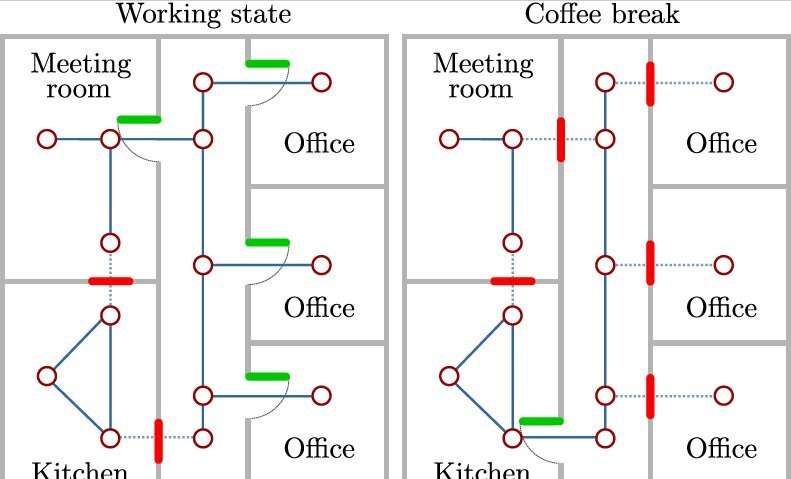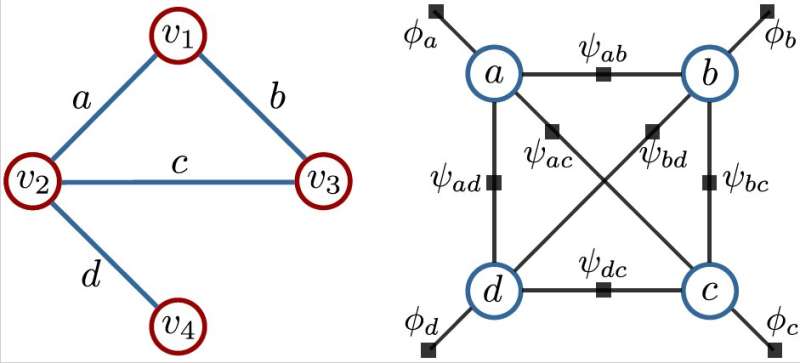October 15, 2019 feature
A new approach to enhance robot navigation in indoor environments

To effectively navigate their surroundings, robots typically plan paths based on pre-designed maps of the environment they are operating in and observations gathered by their sensors. While this type of navigation strategy can be useful in simple and static environments, it is far from ideal in more complex and unpredictable ones, such as the ones found in the real world.
In fact, even if maps fed to a robot have been carefully compiled and are accurate, they do not account for unexpected obstacles or changes in the environment. As most environments in which robots should eventually be deployed (e.g. hospitals, malls, airports, etc.) are highly unpredictable and rapidly changing, navigation approaches that mainly rely on pre-designed maps can result in poor trajectories and navigation strategies.
Aware of this problem, two researchers at the University of Bonn have recently developed an approach that could allow robots to navigate rapidly changing indoor environments more effectively over prolonged periods of time. This new approach, presented in a paper pre-published on arXiv, essentially works by capturing repeating patterns in how an environment is changing and exploiting this knowledge to make informed navigation decisions.
"The idea of this study is that many changes in indoor environments happen following repeating spatial patterns, for example doors opening and closing at the same time," Lorenzo Nardi, one of the researchers who carried out the study, told TechXplore. "Robots that are deployed for longer periods of time in these environments can observe and continuously gather information about it and exploit this knowledge to plan better strategies for navigation."
In a previous study, the same team of researchers developed an approach that gathers information about how a terrain is affecting a robot's navigation outdoors and then uses it to compute trajectories that minimize onboard vibrations and power consumption. In their new study, they decided to focus on robot navigation indoors, by predicting the different configurations that an environment assumes over time.

The approach they developed is designed to enhance a robot's indoor navigation by modeling patterns of dynamic environmental changes and exploiting this information to plan paths for the robot. Using their approach, a robot thus encounters fewer obstacles and blocked passages along its path to a given location.
"The main advantage of our approach is that it considers an environment representation that is able to continuously integrate new observations about the environment," Nardi explained. "This representation allows for planning better trajectories over time than greedy shortest path planners based on static geometric maps of the environment."
The researchers evaluated their approach by applying it to a series of scenarios in four different indoor environments: a small office, a medium office, a large office and a hospital. In these experiments, their approach performed remarkably well, planning effective paths that considered environmental changes. In addition, they compared their approach with existing techniques based on static maps and found that it generates shorter and better paths when the robot is deployed for longer periods of time.
"Our findings show that although the complexity of the navigation system increases, our approach leads the robot over time to provide accurate predictions about environment configurations and exploit this knowledge to navigate along shorter paths," Nardi said.
In the future, the approach proposed by Nardi and his colleague Cyrill Stachniss could help to enhance robot navigation in rapidly changing indoor environments. It could prove particularly useful in settings where a robot's efficiency is critical, such as hospitals. The researchers are now planning to test their approach using an actual robotic platform, as this will ultimately allow them to evaluate whether the initial findings they gathered still hold in real-life settings.
"Another interesting direction for future research could be trying to integrate high-frequency dynamic behaviors, such as other moving dynamic agents, into the framework," Nardi said.
More information: Long-term robot navigation in indoor environments estimating patterns in traversability changes. arXiv:1909.12733 [cs.RO]. arxiv.org/abs/1909.12733
Actively improving robot navigation on different terrains using Gaussian process mixture models. DOI: 10.1109/ICRA.2019.8794079. www.researchgate.net/publicati … ocess_Mixture_Models
© 2019 Science X Network



















